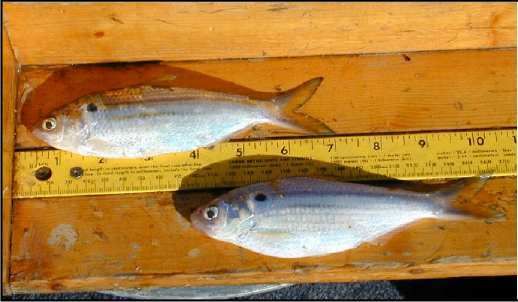GShad

TShad

SRAC 0140: Forage Fish - Introduction and Species
It is important to distinguish between the "look-alike" threadfin shad and the gizzard shad, as normally only the threadfin is suitable for pond stocking. Gizzard shad are considered a problematic species because they grow too large to serve as forage for most predatory fish, and large numbers of big gizzard shad can accumulate in ponds, interfering with the production of other species. Professional pond management services will stock gizzard shad under certain specific conditions to promote trophy bass production, but as a general rule gizzard shad are to be avoided.
Threadfin and gizzard shad both have a thread-like filament at the end of the dorsal (top) fin, so this thread-like fin does not distinguish the threadfin. The best way to tell the two species apart is that the upper jaw of the gizzard shad extends beyond the lower jaw and has a deep notch in the center. The upper jaw of the threadfin does not extend beyond the lower jaw and it is not notched. Both species have a dark spot on the shoulder, although it is typically darker on the gizzard shad. Another difference is that the gizzard shad does not have any yellow on the fins, although it may have a distinctive yellow spot in the white of the eye that is not found in threadfins. The fins of the threadfin usually have a yellowish tint, and the tail fin is often distinctly yellow. The chin and the floor of the mouth of the threadfin have black specks, while there are none on the gizzard shad.